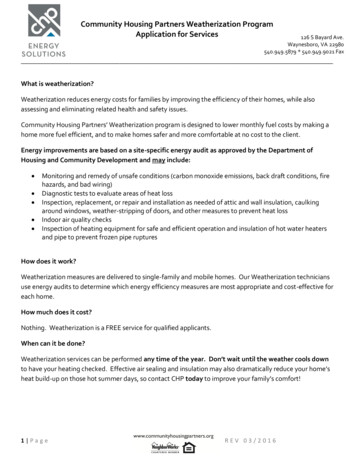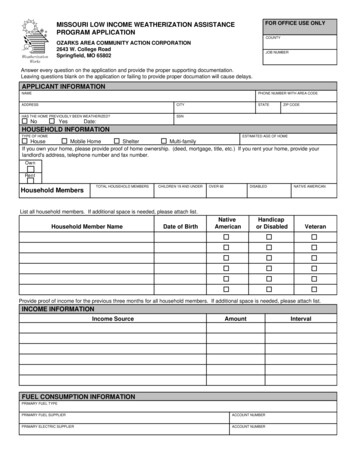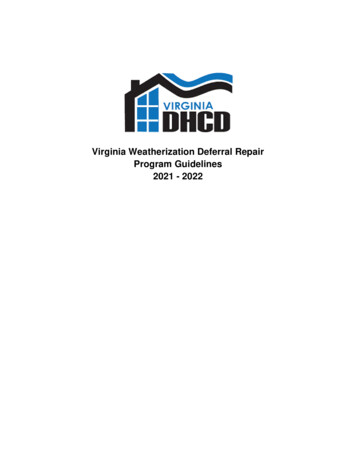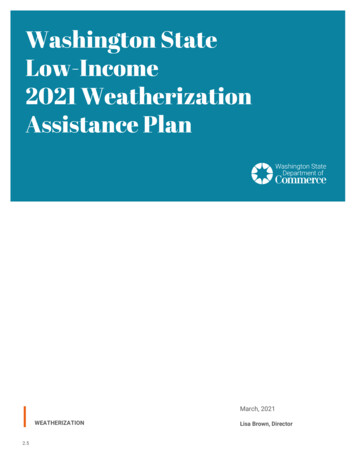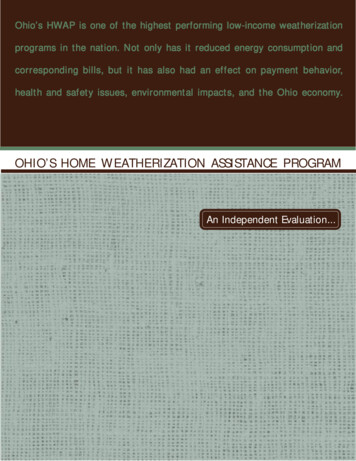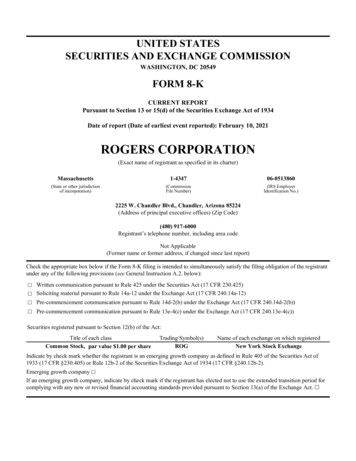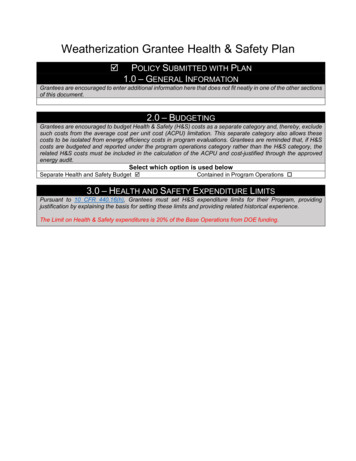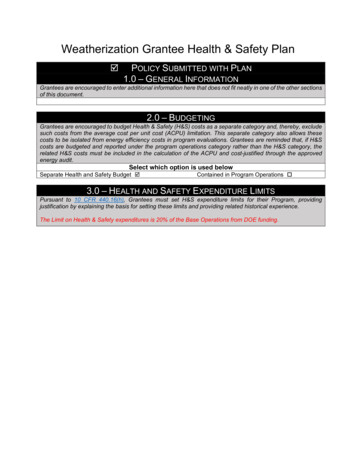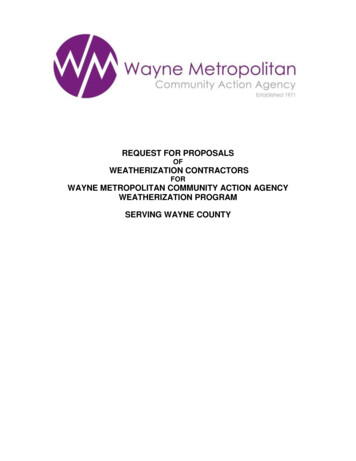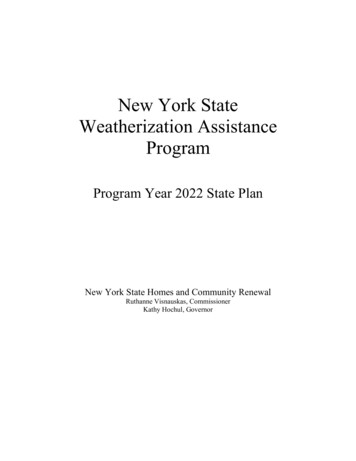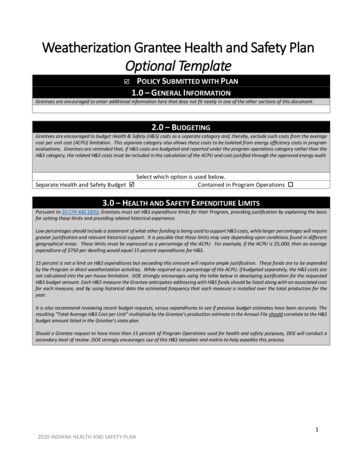
Transcription
Weatherization Grantee Health and Safety PlanOptional Template POLICY SUBMITTED WITH PLAN1.0 – GENERAL INFORMATIONGrantees are encouraged to enter additional information here that does not fit neatly in one of the other sections of this document.2.0 – BUDGETINGGrantees are encouraged to budget Health & Safety (H&S) costs as a separate category and, thereby, exclude such costs from the averagecost per unit cost (ACPU) limitation. This separate category also allows these costs to be isolated from energy efficiency costs in programevaluations. Grantees are reminded that, if H&S costs are budgeted and reported under the program operations category rather than theH&S category, the related H&S costs must be included in the calculation of the ACPU and cost-justified through the approved energy audit.Select which option is used below.Separate Health and Safety Budget Contained in Program Operations 3.0 – HEALTH AND SAFETY EXPENDITURE LIMITSPursuant to 10 CFR 440.16(h), Grantees must set H&S expenditure limits for their Program, providing justification by explaining the basisfor setting these limits and providing related historical experience.Low percentages should include a statement of what other funding is being used to support H&S costs, while larger percentages will requiregreater justification and relevant historical support. It is possible that these limits may vary depending upon conditions found in differentgeographical areas. These limits must be expressed as a percentage of the ACPU. For example, if the ACPU is 5,000, then an averageexpenditure of 750 per dwelling would equal 15 percent expenditures for H&S.15 percent is not a limit on H&S expenditures but exceeding this amount will require ample justification. These funds are to be expendedby the Program in direct weatherization activities. While required as a percentage of the ACPU, if budgeted separately, the H&S costs arenot calculated into the per-house limitation. DOE strongly encourages using the table below in developing justification for the requestedH&S budget amount. Each H&S measure the Grantee anticipates addressing with H&S funds should be listed along with an associated costfor each measure, and by using historical data the estimated frequency that each measure is installed over the total production for theyear.It is also recommend reviewing recent budget requests, versus expenditures to see if previous budget estimates have been accurate. Theresulting “Total Average H&S Cost per Unit” multiplied by the Grantee’s production estimate in the Annual File should correlate to the H&Sbudget amount listed in the Grantee’s state plan.Should a Grantee request to have more than 15 percent of Program Operations used for health and safety purposes, DOE will conduct asecondary level of review. DOE strongly encourages use of this H&S template and matrix to help expedite this process12020 INDIANA HEALTH AND SAFETY PLAN
H&S Measure Matrix - OptionalDouble Click To Open For EditingCells this shade auto calculateEnter Measure iEnter Cost iEnter Frequency % iHeating System Replacement 2,800.0010.0%Heating System Repair 350.0040.0%Water Heater Replacement 1,200.0020.0%Water Heater Repair 150.005.0%Smoke detector 25.0095.0%CO detector 55.0095.0%Minor Roof Repair 250.002.5%Code Compliance 85.005.0%Stove Repair 150.0010.0%Minor Gas Line Repair 100.0020.0%Minor Electrical Repair 150.0015.0%Minor Plumbing Repair 100.005.0%ASHRAE fan installation 620.0040.0%Lead-Safe Work Practices 170.0015.0%Asbestos Testing (in siding, walls, ceilings) 100.003.0%Vapor Barrier Installation 750.0025.0%Gas Appliance Vent Repair/Replacement 100.0037.5%Dehumidifer 225.005.0%Sump Pump 125.005.0%Hazardous Material Removal 100.002.0%Exhaust Fan Installation 90.0015.0%Total Average H&S Cost Per UnitEnter Estimated Production (Annual File: IV.2 WAP Production Schedule) gEnter Estimated Program Operations Budget gH&S Budget (Total Average H&S Cost Per Unit * Estimated Production)Requested H&S Percentage Per Unit (H&S Budget/Program Operations)Auto Calculates 280.00 140.00 240.00 7.50 23.75 52.25 6.25 4.25 15.00 20.00 22.50 5.00 248.00 25.50 3.00 187.50 37.50 11.25 6.25 2.00 13.50 1,351.007475,043,781 1,009,197.0020.0%Please note that in the State Plan, Indiana lists the Health and Safety budget as 1,145,699.69. This is based onthe 2019-2020 Program Year and includes carryover.22020 INDIANA HEALTH AND SAFETY PLAN
4.0 – INCIDENTAL REPAIR MEASURESIf Grantees choose to identify any H&S measures as incidental repair measures (IRMs), they must be implemented as such under theGrantee’s weatherization program in all cases – meaning, they can never be applied to the H&S budget category. In order to be consideredIRMs, the measure must fit the following definition and be cost justified along with the associated efficiency measure;Incidental Repairs means those repairs necessary for the effective performance or preservation of weatherization materials. Such repairsinclude, but are not limited to, framing or repairing windows and doors which could not otherwise be caulked or weather-stripped andproviding protective materials, such as paint, used to seal materials installed under this program. (10 CFR 440 “Definitions”)(1) Source control (i.e. correction of moisture and mold creating conditions) is allowed when necessary in order toweatherize the home and to ensure the long-term stability and durability of the measures. Some measures that addresssource control may include, but are not limited to: drainage, gutters, down spouts, extensions, flashing, sump pumps,dehumidifiers, landscape, leaking roofs, etc. These measures are necessary for the effective performance or preservationof weatherization materials. If the home requires the installation or repair of a moisture barrier, drainage, flashing, sump pump, gutters,downspouts, extensions, flashing, dehumidifiers, or landscaping to ensure the insulation in the crawlspace orsidewalls remains fully intact, the cost of installing the barrier can be included as a necessary cost as a result ofinstalling the insulation. If no insulation is being installed in the crawlspace and any of these items serve toprevent mold and moisture growth alone, this measure is considered a H&S cost. If a Subgrantee is using thePriority List, they are limited to 17% of the total ECM cost as the maximum they can spend on an IRM. IRMscannot exceed 17% of the total ECM cost, but do not have to be limited to the 17% of the ECM cost. All costsabove 17% must be justified using a NEAT/MHEA audit. If the home requires the repair of a roof leak in order to protect insulation installed in the attic or sidewalls of thehome, the cost can be considered an IRM. Homes where no additional insulation is being installed in the attic orwalls that require more than 17% of the total ECM costs for minor roof repairs must be deferred.(2) A vapor or moisture barrier may be installed as either a H&S cost, or as an IRM to air sealing measures if the cost isjustified as part of either a Site-Built Waiver Priority List, or NEAT audit. Otherwise, this is a H&S cost.(3) The installation of an ASHRAE fan is considered an H&S cost, unless cost effective as an ECM.(4) Minor Electrical Repairs, Including Knob Tube: Electrical repairs, including the repair or replacement of knob and tubewiring, may be considered incidental repairs when associated with the installation and preservation of insulation in theattic or sidewalls. Otherwise, this is a H&S cost.(5) Lead-Safe Work Practices may be considered an incidental repair when considering the ECM of insulating the sidewallsof a home. Otherwise, this is a H&S cost.(6) Window and door sealing, repair, or replacement is not an allowable H&S cost and can only considered as an IRM whenconsidering the ECM of insulating the sidewalls of a home.(7) Venting System Replacement: This can be considered an IRM of the ECM of replacing a heating system. Otherwise, thisis a H&S cost.(8) Ductwork Repair / Replacement: This can be considered an IRM of the ECM of replacing a heating system. Otherwise,this is a H&S cost.(9) The installation of a chimney liner for an orphaned water heater may be considered as an IRM of the ECM of repairingor replacing a heating system. Otherwise, this is a H&S cost.(10) Intumescent coating may be considered as an IRM of the ECM of two component foam. Otherwise it can be a Healthand Safety cost.32020 INDIANA HEALTH AND SAFETY PLAN
Deferral of services may be necessary if H&S issues cannot be adequately addressed according to WPN 17-06 guidance. The decision todefer work in a dwelling is difficult but necessary in some cases. This does not mean that assistance will never be available, but that workmust be postponed until the problems can be resolved and/or alternative sources of help are found. If, in the judgment of the auditor, anyconditions exist which may endanger the health and/or safety of the workers or occupants, the unit should be deferred until the conditionsare corrected. Deferral may also be necessary where occupants are uncooperative, abusive, or threatening. Grantees must be specific intheir approach and provide the process for clients to be notified in writing of the deferral and what conditions must be met forweatherization to continue. Grantees must also provide a process for the client to appeal the deferral decision to a higher level in theorganization.Grantee has developed a comprehensive written deferral/referral policy that covers both H&S, and otherdeferral reasons?Yes No Where can this deferral/referral policy be accessed?See Section 4.4 of the Indiana Policy and Procedures Manual, Deferral .htm.6.0 – HAZARD IDENTIFICATION AND NOTIFICATION FORM(S)Documentation forms must be developed that include at a minimum: the client's name and address, dates of the audit/assessment andwhen the client was informed of a potential H&S issue, a clear description of the problem, a statement indicating if, or when weatherizationcould continue, and the client(s) signature(s) indicating that they understand and have been informed of their rights and options.Documentation Form(s) have been developed and comply with guidance?Yes No 7.0 – HEALTH AND SAFETY CATEGORIESFor each of the following H&S categories identified by DOE: Explain whether you concur with existing guidance from WPN 17-07 and how that guidance will be implemented in yourProgram, if you are proposing an alternative action/allowability, or if the identified category will not be addressed and willalways result in deferral. Alternatives must be comprehensively explained and meet the intent of DOE guidance.Where an Action/Allowability or Testing is “required” or “not allowed” through WPN 17-06, Grantees must concur, or choose todefer all units where the specific category is encountered.“Allowable” items under WPN 17-07 leave room for Grantees to determine if the category, or testing, will be addressed and inwhat circumstances.Declare whether DOE funds or alternate funding source(s) will be used to address the particular category.Describe the explicit methods to remedy the specific category.Describe what testing protocols (if any) will be used.Define minimum thresholds that determine minor and major repairsIdentify minimum documentation requirements for at-risk occupantsDiscuss what explicit steps will be taken to educate the client, if any, on the specific category if this is not explained elsewherein the Plan. Some categories, like mold and moisture, require client education.Discuss how training and certification requirements will be provided for the specific category. Some categories, like Lead BasedPaint, require training.Describe how occupant health and safety concerns and conditions will be solicited and documentedGrantees may include additional H&S categories for their particular Programs. Additional categories must include, at a minimum, all ofthe same data fields as the DOE-provided categories. Two additional tables have been created to utilize.42020 INDIANA HEALTH AND SAFETY PLAN
7.1 – Air Conditioning and Heating SystemsConcurrence, Alternative, or DeferralConcurrence with Guidance Alternative Guidance Results in Deferral Air Conditioning Unallowable Measure Heating Unallowable Measure FundingDOE LIHEAP State Utility Other How do you address unsafe or non-functioning primary heating/cooling systems?If the heating system is operable, the system must be run through NEAT, MHEA, or MulTEA first to determine if it isallowable to be replaced as an energy conservation measure. As Indiana is considered a heating state, if the NEAT, MHEA,or MulTEA audit calls for a replacement, only the heating system would be replaced. "Red tagged," inoperable ornonexistent heating system replacement, repair, or installation is allowed with DOE funds and LIHEAP funds. Repairs to anair conditioning system may only be made when current operations of the AC system inhibit or affect the operation of thefurnace, or when the cooling system is an integral part of the operation of the heating system, such as a heat pump (Forinstance, if the A-coil above a furnace is leaking water onto the heat exchanger, the A-coil can be replaced. Repairs tooutside units is generally not allowable). Repairs can be charged as DOE Health and Safety cost or LIHEAP Mechanical cost.The subgrantee must first determine whether repairs can effectively be made to the heating system to enable it tooperate safely, rather than require a replacement.Sub-grantees are allowed to replace heating systems in the following circumstances: A verifiable condition exists that allows combustion gases to enter the living environment. For example, a breach inthe heat exchanger that allows combustion gases to mix with the air in the ductwork. An improper application of a non-sealed combustion furnace installed in a manufactured home. Manufactured homesare required to have furnaces that draw their combustion air from outside the carriage. All new furnace installationsin manufactured homes must be approved for use in manufactured housing. Heating systems can be replaced when the NEAT, MHEA, or MulTEA audit shows the replacement to meet an SIR of 1or greater. Subgrantees must run a NEAT/MHEA/MulTEA audit when DOE funding is used to pay for a furnacereplacement. The NEAT/MHEA/MulTEA workscope must be followed once a NEAT/MHEA/MulTEA audit has beenperformed on a structure. The cost of necessary repairs will exceed 50% of the cost of replacing the heating system. Replacement parts are no longer produced or available. If the fuel source is no longer available to the client, the Subgrantee must submit a request to IHCDA requesting thechange of the fuel source and heating system, and requests will be evaluated on a case-by-case basis. Subgrantees must request approval from IHCDA prior to weatherizing homes without an existing heat source.The subgrantee may not continue with weatherization work, particularly air sealing the structure until the combustiongases have been appropriately vented away from the living area. In the case of a plugged or non-functioning vent on acombustion appliance, appropriate steps must be taken to repair, or replace the vent.Before a furnace is installed in a weatherization dwelling unit, the proper size of the furnace must be determined.Subgrantees will determine the most effective output size of the replacement heating system using a Manual-J based heatload calculation. NEAT/MHEA/MulTEA are not approved heat load calculation tools.Furnace replacements in Indiana’s Weatherization Assistance Program are justified by utilizing Indiana's Heating DegreeDays; the lower one-third of the state has a range of 4000 – 5499, and 5500 – 7000 for the upper two-thirds of the State.This climatic information is incorporated into Indiana’s NEAT, MHEA, and MulTEA runs as well as their Site Built andMobile Home Waiver Audits.How do you address unsafe or non-functioning secondary heating systems, Including unvented secondaryspace heaters?52020 INDIANA HEALTH AND SAFETY PLAN
Unsafe secondary units, including space heaters must be removed, rendered inoperable, or deferral isrequired.Following WPN 17-7, secondary unvented units that conform to the safety standards of ANSI Z21.11.2 mayremain as back-up heat sources. DOE is allowing this flexibility primarily to provide low income clients anemergency back-up source of heat in the event of electrical power outages. In order to leave a secondary unitbehind as secondary source of heat, the unit must pass the IHCDA Unvented Space Heater Inspection and beproperly documented on the form.Secondary unvented units that do not meet ANSI Z21.11.2 must be removed and properly disposed of prior toweatherization but may remain until a replacement heating system is in place. Repair of secondary unventedunits is not allowed. Secondary unvented units that meet the ANSI Z21.11.2, but are not operating safely, mustbe removed and properly disposed of.An unvented gas- or liquid-fueled space heaters that remain in a completed single-family house afterweatherization shall: Not have an input rating in excess of 40,000 Btu/hour; Not be located in, or obtain combustion air from sleeping rooms, bathrooms, toilet rooms, or storageclosets.IHCDA does not permit any DOE-funded weatherization work on electric space heaters. Repair, replacement,or installation of electric standalone space heaters is not allowed. Removal of these space heaters isrecommended. The energy auditor is required to perform a complete evaluation of the heating system on eachunit weatherized. Part of this evaluation will be determining what modifications or replacements are required.Standalone electric heaters cannot be left in place as a client’s sole source of heat. If provisions cannot bemade for the installation of a permanent heating source, the home must be deferred. In instances where anew heating system is installed, the client will be educated on the new heating system and advised againstusing the stand-alone electric space heater. Should the stand-alone electric space heater be found to be unsafefor use in the client’s home, it must be removed from use prior to weatherization proceeding.Unvented gas- or liquid-fueled space heaters must be removed and properly disposed of prior toweatherization in manufactured homes.Indicate Documentation Required for At-Risk OccupantsAuditors determine and document presence of “at-risk” current occupants when installing any Health andSafety measure.Testing Protocols62020 INDIANA HEALTH AND SAFETY PLAN
Health and safety inspections ensure that systems are present, operable, and performing. The health andsafety inspection of combustion appliances, including heating systems, includes the following items, but arenot limited to: The rated and measured BTU input of each combustion applianceA complete electrical inspection of the furnace including proper grounding, polarity, wiring connections,fuse type and size, element amperage (electrical furnace), disconnect requirements and conduitrequirementsAn inspection of all fuel lines in the home from the source to the combustion appliance or line termination.This includes all fittings, connections, shut-off valves, gas valves, sediment traps and end capsAn inspection for spillage and a reading of the draft of gas/oil furnaces and water heaters (Completion ofthe appropriate Inspection Form)A visual check for flame interferenceA test of the setting and operation of the high limit control switchAn evaluation of the adequacy of combustion air for combustion appliancesA check that there are no open return air ducts/leaks in the Combustion Appliance ZoneCarbon monoxide testing of all combustion appliancesAn inspection, and replacement if necessary, of the furnace filterWorst case CAZ depressurization and Indiana Daily Safety Test-Out FormClient EducationWhen deferral is necessary, provide information to the client, in writing, describing conditions that mustbe met in order for weatherization to commence. A copy of this notification must also be placed in theclient file.Discuss appropriate use and maintenance of units.Provide all paperwork and manuals for any installed equipment.Discuss and provide information on proper disposal of bulk fuel tanks when not removed as part of theweatherization work.Where combustion equipment is present, provide safety information including how to recognizedepressurization.TrainingWAP Health and Safety policy training on allowable activities.Licensing and/or certification for HVAC installers as required by authority having jurisdiction (AHJ).CAZ depressurization test and inspection training.72020 INDIANA HEALTH AND SAFETY PLAN
7.2 - Asbestos - AllWhat is the blower door testing policy when suspected Asbestos Containing Material (ACM) is identified?Weatherization workers must recognize materials that may contain asbestos and avoid disturbing them. PerWPN 17-7, Subgrantees must not perform a blower door depressurization test in a building where friableasbestos, suspected asbestos containing insulation or vermiculite are present. Unless the suspect material hastested negative for asbestos, a blower door pressurization test must be performed, and must be documentedin the client file. When suspected asbestos containing materials are present, assume that asbestos is present unless testinghas determined otherwise. Sample collection and testing must be done by a certified asbestos control professional. Baseline environmental asbestos sampling is an allowable H&S cost. If the Subgrantee has deferred a home which then results in the owner removing asbestos containingmaterials, it is required that the proper documentation be provided to the Subgrantee prior to allowingweatherization services to move forward.7.2a – Asbestos - in siding, walls, ceilings, etc.Concurrence with Guidance Concurrence, Alternative, or DeferralAlternative Guidance Results in Deferral FundingDOE LIHEAP State Utility Other How do you address suspected ACM’s in siding, walls, or ceilings that will be disturbed through the course ofweatherization work? The existence of asbestos siding that is in good condition does not prevent installing dense-pack insulationfrom the exterior. Siding may be removed and reinstalled in order to perform the ECM, and the associated costs may becharged as part of the ECM. All trash and debris must be removed and disposed at the end of each day of in accordance with allapplicable AHJ from the worksite by the person(s) completing dense-pack insulation from the exterior General abatement of asbestos siding or replacement with new siding is not an allowable H&S cost.Abatement of asbestos siding or replacement with new siding may be considered an allowable StateLIHEAP or LIHEAP cost on a case-by-case basis.If there is suspected asbestos containing insulation found in a unit and that suspected asbestos containinginsulation will require disturbance in order to complete weatherization activities, then the suspected asbestoscontaining insulation must either (a) be tested by an AHERA professional to determine if asbestos is present or(b) must be assumed to contain asbestos. If it is tested and the results are positive, then either (a) the ACMmust be removed in accordance with WPN 17-7 guidance prior to weatherization activities commencing or (b)the home must be deferred until the ACM can be removed in accordance with WPN 17-7. Testing ProtocolsVisually inspect exterior wall surface and subsurface, floors, walls, and ceilings for suspectedACM prior to drilling or cutting.Asbestos Hazard Emergency Response Act of 1986 (AHERA) sample collection and testing must beconducted by a certified tester.Client Education82020 INDIANA HEALTH AND SAFETY PLAN
Inform the client in writing that suspected ACMs are present and what precautions will be taken to ensurethe occupants’ and workers’ safety during weatherization.Formally notify client in writing of results if testing was performed.Training and Certification RequirementsAsbestos certification is not required by IHCDA, and as such, IHCDA does not cover the cost for asbestoscertification. Basic knowledge of asbestos is covered within the scope of other Weatherization trainingsoffered through INCAA.Contractor training courses will teach safe practices for siding removal and replacement and how toidentify asbestos containing materials.How to identify suspected ACM.Licensing/certification for removal and reinstallation of asbestos siding if required by AHJ.7.2b – Asbestos - in vermiculiteConcurrence with Guidance DOE LIHEAP Concurrence, Alternative, or DeferralAlternative Guidance FundingState Utility Results in Deferral Other How do you address suspected ACM’s in vermiculite that will be disturbed through the course ofweatherization work?If there is vermiculite insulation found in a unit and the vermiculite insulation will require disturbance in orderto complete weatherization activities, then the vermiculite insulation must either:(a) be tested by an AHERA professional to determine if asbestos is present or(b) must be assumed to contain asbestos.If it is tested and the results are positive, then either (a) the ACM must be removed in accordance with WPN17-7 guidance prior to weatherization activities commencing or (b) the home must be deferred until the ACMcan be removed in accordance with WPN 17-7. When vermiculite is present, and it is determined that testing will be completed, testing is required by anAHERA or other appropriate asbestos control professional.If asbestos is present, the home must be able to be weatherized without asbestos disturbance. If it can’t,then it must be deferred.Do not perform a blower door depressurization test.A blower door pressurization test is allowable.Use proper respiratory protection while in areas containing vermiculite.Encapsulation by an appropriately trained asbestos control professional is allowed.Removal is not an allowable cost.When deferral is necessary due to asbestos, occupant must provide documentation that a certifiedprofessional performed the remediation before work continues.Testing ProtocolsAHERA sample collection and testing must be conducted by a certified tester.Baseline environmental asbestos sampling is an allowable H&S cost.Client Education92020 INDIANA HEALTH AND SAFETY PLAN
Instruct clients in writing not to disturb suspected ACM.Provide asbestos safety information to the client.Formally notify client in writing of results if testing was performed.When deferral is necessary, provide information in writing describing conditions that must be met in orderfor weatherization to commence.Training and Certification RequirementsTraining on how to recognize vermiculite.AHERA or state certification to conduct testing.AHERA or other appropriate asbestos control professional certification/training for encapsulation.7.2c – Asbestos - on pipes, furnaces, other small covered surfacesConcurrence with Guidance Concurrence, Alternative, or DeferralAlternative Guidance Results in Deferral FundingDOE LIHEAP State Utility Other How do you address suspected ACM’s (e.g., pipes, furnaces, other small surfaces) that will be disturbedthrough the course of weatherization work?Assume asbestos is present in suspect covering materials.When suspected friable ACM is present, take precautionary measures as if it is asbestos unless testingdetermines otherwise.Encapsulation by an appropriately trained asbestos control professional is allowed and may be conductedprior to blower door testing if the materials are friable.Subgrantee may be allowed to remove by an appropriately trained professional on a case-by-case basis.Grantees must state in the H&S Plan what criteria the Grantee uses when reviewing requests.Charge only those costs directly associated with the testing, encapsulation, or removal to the H&S budgetcategory.When deferral is necessary due to asbestos, occupant must provide documentation that a certifiedprofessional performed the remediation before work continues.Testing ProtocolsAssess whether suspected ACMs are present.AHERA sample collection and testing is allowed and must be conducted by a certified tester.Client EducationInstruct clients in writing not to disturb suspected ACM.Provide asbestos safety information to the client.Formally notify client in writing of results if testing was performed.When deferral is necessary, provide information in writing describing conditions that must be met in orderfor weatherization to commence.Training and Certification RequirementsHow to recognize suspected ACM.AHERA or other appropriate asbestos control professional certification/training is required to abate theACM.102020 INDIANA HEALTH AND SAFETY PLAN
7.5 – Biologicals and Unsanitary Conditions(odors, mustiness, bacteria, viruses, raw sewage, rotting wood, etc.)Concurrence with Guidance DOE LIHEAP Concurrence, Alternative, or DeferralAlternative Guidance Unallowable Measure FundingState Utility Results in Deferral Other What guidance do you provide Subgrantees for dealing with biological and/or unsanitary conditions inhomes slated for weatherization? Remediation of conditions that may lead to or promote biological concerns and unsanitary conditions isallowed. Addressing bacteria and viruses is not an allowable cost. Deferral may be necessary in cases where conditions in the home pose a health risk to occupants and/orweatherization workers.Testing ProtocolsAuditors will conduct a sensory inspection for biological and unsanitary conditions.Client EducationAuditors will inform the client, in writing, of observed conditions. Auditors will provide information on how tomaintain a sanitary home and steps to correct deferral conditions. When deferral is necessary, provideinformation in writing describing condi
(9) The installation of a chimney liner for an orphaned water heater may be considered as an IRM of the ECM of repairing or replacing a heating system. Otherwise, this is a H&S cost. (10) Intumescent coating may be considered as an IRM of the ECM of two component foam. Otherwise it can be a Health and Safety cost.
